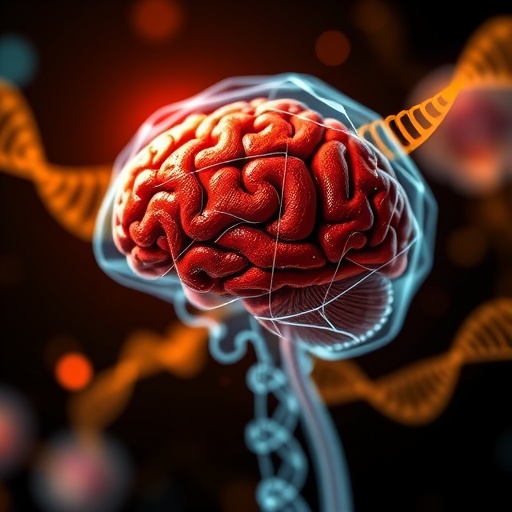‘Rogue’ DNA Rings Offer Groundbreaking Insights into Early Development and Aggressiveness of Glioblastoma
A pioneering international research effort has uncovered how circular, extrachromosomal DNA rings—termed ecDNA—play a critical role in propelling the growth and treatment resistance of glioblastoma, the most lethal and prevalent form of adult brain cancer. These rogue DNA elements, which exist independently from the chromosomes within cancer cells, are now understood to be not just a hallmark but potentially an initial driver in glioblastoma’s onset, offering promising avenues for earlier diagnosis and more effective therapeutic interventions.
Published today in Cancer Discovery, this transformative study, led by Dr. Benjamin Werner of Queen Mary University of London alongside Professor Paul Mischel from Stanford University and Professor Charlie Swanton at The Francis Crick Institute, reveals an unprecedented timeline of ecDNA’s role. Through cutting-edge genomic analyses paired with computational modeling, researchers showed that ecDNA containing oncogenes frequently appears at the earliest stages of tumorigenesis—even preceding the physical formation of tumors in some instances. This discovery redefines our understanding of tumor biology, highlighting ecDNA as a precursor that primes glioblastoma for rapid growth, genetic diversity, and drug resistance.
Glioblastoma remains one of the most recalcitrant cancers, with a median survival rate stubbornly lingering around 14 months despite numerous therapeutic advances. A key reason for such dismal outcomes lies in its molecular complexity and capacity for swift adaptation. EcDNA, long known to exist in various cancers, has evaded comprehensive understanding due to its elusive nature and dynamic behavior. The Cancer Grand Challenges initiative—hosted by Cancer Research UK in collaboration with the US National Cancer Institute—has prioritized decoding ecDNA’s mysteries, funding an international consortium named eDyNAmiC with a $25 million grant in 2022. This multidisciplinary team combines expertise from cancer biology, mathematics, computer science, and clinical research to systematically unravel the spatiotemporal evolution of ecDNA in tumors.
The researchers adopted a novel “archaeological” approach to tumor investigation, collecting multiple spatially distinct tissue samples across each patient’s glioblastoma. This thorough sampling provided a genomic landscape that exhibited the heterogeneity and evolution patterns of ecDNA, rather than relying on conventional single-biopsy snapshots. Advanced computational simulations—running through millions of possible evolutionary scenarios—enabled the team to reconstruct the timeline of ecDNA genesis and expansion within tumors. This evolutionary portrait offered critical insights into how ecDNA confers aggressive traits and promotes intratumoral diversity, a major contributor to treatment failure.
A focal point of these rogue DNA circles was the epidermal growth factor receptor (EGFR) oncogene, widely recognized for its role in driving cellular proliferation. The study found that EGFR-bearing ecDNA not only emerged early but also underwent further genetic alterations, such as the notorious EGFRvIII mutation. This variant enhances oncogenic signaling and confers increased resistance to standard therapies, further exacerbating glioblastoma’s aggressiveness. The early presence of EGFR ecDNA suggests a critical window during which therapeutic targeting or disease interception could be more feasible, before the evolution of highly resistant tumor subclones.
Dr. Magnus Haughey, a lead author on the paper, highlighted the clinical implications: “If reliable diagnostic tools—such as blood-based assays—can be developed to detect EGFR ecDNA at the earliest stages, it may revolutionize glioblastoma management by enabling intervention before the tumor evolves into its more formidable forms.” This concept hints at a paradigm shift toward precision oncology, where monitoring the ecDNA landscape could guide personalized treatment strategies and adaptive therapies.
Importantly, ecDNA was shown to sometimes harbor multiple oncogenes simultaneously, contributing to unique evolutionary pressures on tumor cells. This multiplexed oncogene carriage supports the idea that glioblastoma’s intratumoral heterogeneity is, in part, ecDNA-driven, complicating treatment responses but also presenting an opportunity to tailor interventions based on a tumor’s specific ecDNA signature. Understanding these complex genetic architectures is essential to overcoming the barriers of drug resistance and tumor relapse.
Despite these groundbreaking strides, many fundamental questions about ecDNA’s biology remain. The eDyNAmiC team intends to investigate how various clinically relevant treatments shape ecDNA populations over time, and to what extent they can be manipulated or eradicated. Furthermore, expanding the focus beyond glioblastoma to additional cancer types will help determine the broader applicability of ecDNA-based diagnostics and therapeutics.
Professor Charlie Swanton articulated the significance of this research, emphasizing the transformative potential of these findings: “By pinpointing when and how ecDNA arises, we reshape our capacity to detect glioblastoma early, intervene sooner, and ultimately improve survival outcomes. This study is a critical step toward a new era in oncology where genomic instability is not an insurmountable challenge but a targetable vulnerability.”
From Stanford, Professor Paul Mischel echoed these sentiments, highlighting the dual nature of ecDNA’s emergence. “EcDNA can appear both at precancerous stages and during later progression, driving heterogeneity and resistance. Our findings underscore that glioblastoma could be amenable to early detection and intervention strategies centered on ecDNA dynamics, potentially changing the clinical trajectory of this intractable cancer.”
Dr. David Scott, Director of Cancer Grand Challenges, praised the collaborative spirit of the international team, noting that their integrative methodology exemplifies the future of cancer research. By merging evolutionary biology with clinical science and computational modeling, eDyNAmiC dismantles traditional disciplinary silos and pushes the boundaries of what is achievable. Their work not only deepens fundamental understanding but illuminates tangible paths toward earlier diagnosis, better monitoring, and smarter, more effective treatments for glioblastoma and other formidable cancers.
This study’s revelations about extrachromosomal DNA highlight a crucial and previously underappreciated layer of tumor evolution and aggression. As research progresses, ecDNA may become a cornerstone biomarker and therapeutic target, transforming one of the deadliest brain cancers from an unstoppable adversary into a conquerable foe.
Subject of Research: Human tissue samples
Article Title: Extrachromosomal DNA driven oncogene spatial heterogeneity and evolution in glioblastoma
News Publication Date: 8-Sep-2025
Web References: https://doi.org/10.1158/2159-8290.CD-24-1555
Keywords: Brain cancer, Cancer genomics, Glioblastomas, Cancer, DNA




